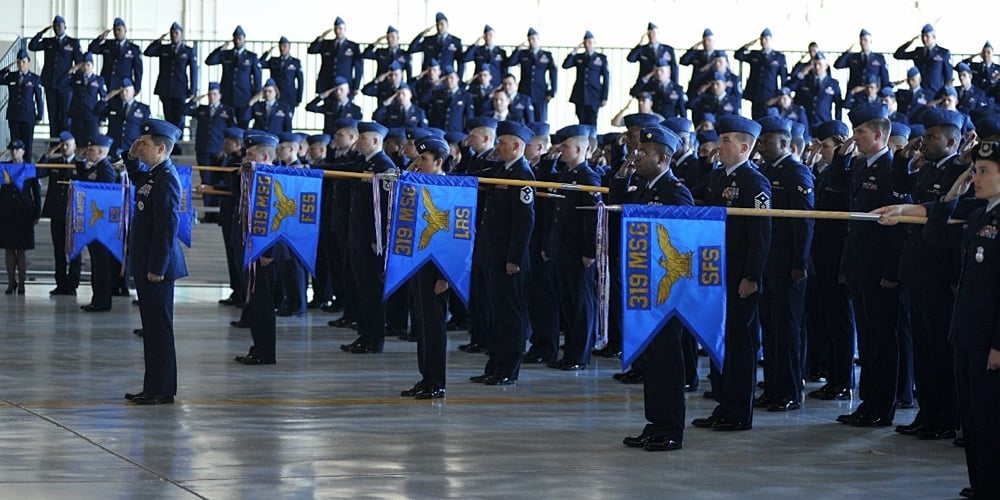Traditions and customs – Why they matter
 Col Hernandez’s Final Salute after a 25-Year Career (in Service Dress Uniforms)
Col Hernandez’s Final Salute after a 25-Year Career (in Service Dress Uniforms)
Throughout my Air Force career, I saw many changes that have had a profound impact on the way our Air Force flies, fights, and wins. At the time, I didn’t think much of these changes as they appeared to be “adapting to modern times” or “getting rid of the old ways” in the hope that somehow operations would improve. As I look back, none of these promises did much to advance the service and, in some ways, they degraded unit cohesiveness at all levels of command.
For instance, early in my career there was a shift from Air Force Regulations to Air Force Instructions. This was intended to allow for better “discretion” in executing the mission. Regulations were thought to be too rigid, measured too objectively, and always assigned direct accountability for non-compliance. Plus, measuring compliance was paperwork intensive.
Consequently, unit inspections also went away for many of the same reasons. It was believed that Airmen were too busy fighting the war to prepare for the inspection much less document compliance and get-well plans.
Similarly, the Air Force did away with leather boots and opted for a suede boot which no longer required “spit-shining” (i.e., shoe polish with cotton swabs and water). This was a time-honored tradition that required attention to detail and lots of “elbow grease.” Plus, it didn’t matter if you were an officer or enlisted member—everyone had to meet the same dress and appearance standards. Thus, there was always a boot-shining “party” taking place somewhere in the squadron.
Along the same time suede boots appeared, the Air Force shifted from wearing blues while in the office to an Airman Battle Uniform or a Flight Suit (for aircrews). It used to be that wearing your blues reflected pride. Unfortunately, over time it seemed Airmen were only required to dress in blues when getting an Article 15 punishment, making a Court-Martial appearance, or in the unlucky event they were “voluntold” to represent the unit at a function off-base. Thus, wearing blues became a negative aspect of military life rather than a point of pride.
Cumulatively, all these changes had a detrimental effect on the unit.
As commanders, we needed to make changes to remedy this, which meant getting back to the traditions and customs that served a purpose. Being ready for war is what America expects from its military. Regulations and inspections serve a purpose since it is very bad for a commander to certify the readiness of the unit and not meet expected standards. Subjective assessments and good intentions don’t win wars. The enemy simply doesn’t care if you are trying hard—cold, hard, objective facts matter.
Shining boots allowed for time to share stories and impart unit wisdom. I can’t tell you how much I learned from both superiors and direct reports when we took the time to shine our boots together. These helped build common bonds which matter in combat. Plus, there are some things you can immediately gather about a unit’s effectiveness just walking in the front door. If all the boots were shined regardless of the time you visited the unit, it was a leading indicator that unit command/leadership at all levels were good to go. If boots were dirty and scuffed, you could expect other problems. Inspections proved this!
Pride in wearing the dress uniform each day required attention to detail. Again, it was a good indicator on how the unit was performing. Properly displaying rank, insignia, and ribbons meant that a member’s professional appearance was likely to show in their work and in preparations for war. Thus, traditions and customs, while hard and sometimes seemingly meaningless, do matter in guaranteeing the success of the unit.
My point in writing all this—there are certain traditions and customs in our industry that still matter. Despite technological shifts, the rise of FinTechs, or social changes—there are those absolutes that will always set credit unions apart from other financial service providers. There is an ethos, a commitment to our member-owners, and to our communities that must be preserved.
As leaders, we should always take time to communicate what this means. Even though credit union employees are not required to shine boots, there are plenty of volunteer activities that can foster storytelling or imparting wisdom that reinforce industry customs and traditions.
While there is credit union apparel featuring standard logos and colors, wearing a uniform is not something we require of our employees—at least not to the extent of the military. Yet, attitude and service are the “uniforms” others see when walking in the front door. There is a certain pride members should feel at first contact.
Finally, objective measures demonstrate mission readiness. There are many measures and metrics we can define internally to assess our ability to serve our members. The NCUA also provides plenty of objective ways to measure compliance. Good, bad, or indifferent, these metrics and exams serve a purpose. It takes leadership at all levels to ensure compliance throughout the organization.
There are many parallels between military service and the credit union industry. It is up to leaders to keep up the pace and not trade away our credibility/readiness in the market. The good news is our industry has a phenomenal track record. Looking ahead, I have great faith that our industry will continue to value the traditions and customs that made us who we are today!

